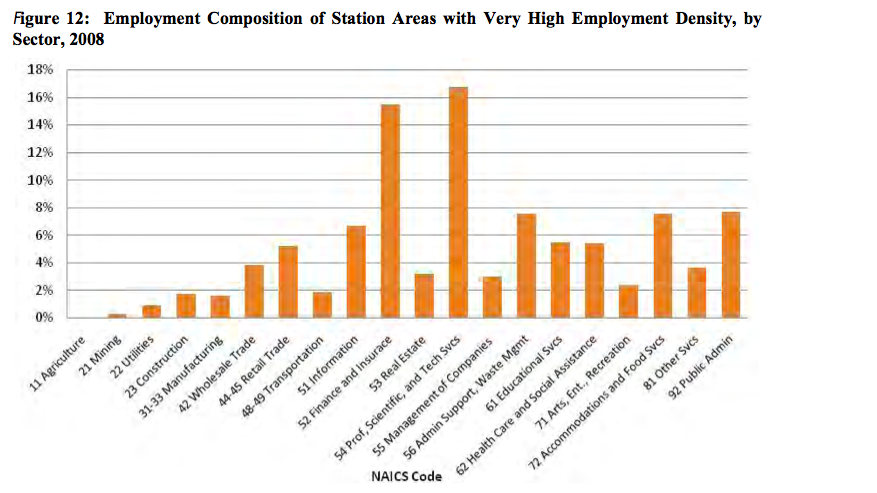CENTER FOR TRANSIT-ORIENTED DEVELOPMENT
Introduction
In many regions throughout the country, the fastest growing employment centers are now located in auto-oriented suburban communities at the edge of metropolitan regions. From a public transportation perspective, dispersed and low-density employment centers are very difficult to serve through fixed-guideway transit. The location of new jobs at the edge also has important equity implications, as low-income residents have difficulty accessing jobs in auto-oriented suburbs from their inner city, urban, or rural neighborhoods. This can result in a significant cost to households and individuals as they spend more time and money commuting to work. Furthermore, there are important environmental impacts from job sprawl, including an increase in land consumption, and greater pollution and greenhouse gas emissions.
In order to promote more sustainable and equitable regions, many policy makers at the local and regional levels are working to find ways to concentrate future employment growth in higher density mixed-use districts. Transit is seen as a central mechanism for facilitating increased densities in the core, countering dispersal trends. At the same time, transit agencies are increasingly focusing efforts on providing transit corridors that serve major existing employment centers in order to promote ridership and sustain healthy operations.
A closer look at employment decentralization patterns by industry sector reveals that there are important nuances within the overall trends towards job sprawl. Research indicates that some types of firms may have a preference for higher-density urban locations, and can benefit from agglomeration. For example, a recent Brookings study showed that of all employment categories, manufacturing jobs were the most suburbanized, with 77 percent located more than five miles from city centers; by contrast, skill-intensive jobs were the least suburbanized, at 67 percent.
This paper examines the composition of existing employment in areas served by fixed-guideway rail transit5, and explores how industries vary in their proclivity to locate in higher density, transit-served locations. It also assesses which industries have experienced recent growth near transit in absolute numbers, even though they may have a declining share of total employment in transit areas. The outcome of this analysis is a better understanding of the types of industries that may have a greater propensity to be transit-oriented. This paper is intended to provide a framework for how the coordination of regional economic development, land use and transportation planning efforts can better promote healthy, high-functioning regions.
This effort is a companion to CTOD’s report, “Transit-Oriented Development and Employment” which explores the need to consider regional employment centers in planning transit systems, and discusses how destinations and workplaces can be better incorporated into the discussion of transit-oriented development (TOD). This paper builds on the findings of that document, while focusing primarily on the location decisions of employers. Specifically, this report explores the differential benefits of density near transit to various industries. This frame is used to analyze the degree to which different industry sectors are currently attracted to transit-rich locations and to examine the character of employment clusters that are located near transit.
The analyses of this paper engage the question of how employment patterns relate to transit. It further assesses how regional economic development and land uses policies can leverage the location preferences of specific industries in order to foster economic growth near transit, rather than in auto-dependent locations. Findings from this paper will be of interest to regional economic development planners working to build long-term structural capacity for economic growth. It will also be of interest to transit planners that seek to maximize regional employment access and achieve high levels of ridership. Policymakers and planners will be able to use this paper to identify which industries currently express the greatest affinity toward transit and, thus, may be most appropriate to target for recruitment or retention in transit-oriented locations. The findings of this paper may also be help to make more cost-effective transit investments to better serve transit-oriented businesses and their employees.
Download full version (PDF): Transit and Regional Economic Development
About the Center for Transit-Oriented Development
www.ctod.org
“CTOD works to integrate local and regional planning, generate new tools for economic development, real estate and investment issues, improve affordability
and livability for all members of the community, and respond to imperatives for climate change and sustainability. The Center for TOD is a partnership of Reconnecting America, the Center for Neighborhood Technology, and Strategic Economics.”
Tags: Center for Transit Oriented Development, CTOD, Reconnecting America, TOD, Transit-Oriented Development







 RSS Feed
RSS Feed